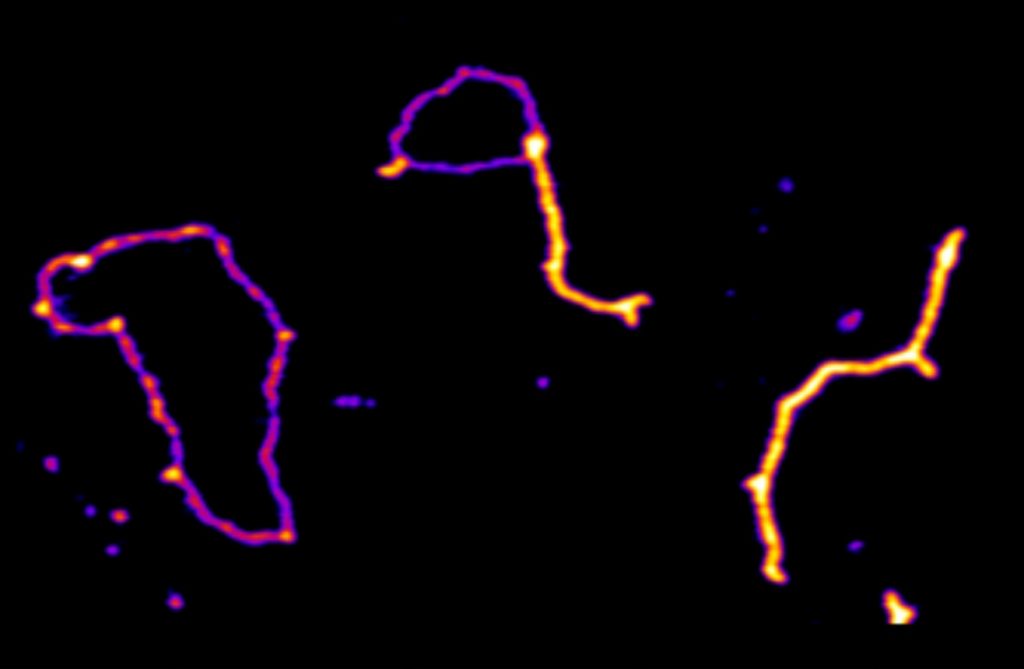CCS in Nature: Human cells surprise with feature hitherto found only in organisms living at high temperatures
A study coordinated by a team from the Center for Chromosome Stability (CCS), University of Copenhagen, finds that human cells possess what was thought to be a feature restricted to organisms living at very high temperatures. The study was recently published in the scientific journal Nature Structural & Molecular Biology.

The double helical structure of DNA, where two DNA strands coil around each other, is one of the most iconic images in modern biology. This coiled conformation ensures that the paired so-called DNA bases (A-T and G-C) that carry the code for our genetic information are confined in the center of a protective DNA fiber.
However, to access this genetic information, cellular machineries must open up the double helix. This requirement creates a dilemma for cells: the genetic information must be accessible while still being protected. Hence, all living organisms continuously balance the dynamic opening and closure of their DNA.
This balance can be achieved by controlling a feature of the structure of DNA called topology, which describes how many times the two strands of DNA are wrapped around one another. Indeed, most living organisms keep their DNA slightly “underwound” (or negatively supercoiled), because this helps in opening DNA and gaining rapid access to the genetic code. On the other hand, “overwound” DNA (or positively supercoiled) is usually considered a toxic conformation because it prevents DNA from opening and thereby is expected to inhibit any cellular process that requires access to the genetic information.
In a recent study published in Nature Structural & Molecular Biology, researchers from the CCS teamed up with physicists from Copenhagen and Paris to show that two human proteins, called PICH (a DNA translocase) and TOP3 (a DNA topoisomerase), cooperate to introduce a very high density of positive supercoiling into DNA. Such an activity – called a “reverse gyrase” – has hitherto only been found in some unusual species that live in extremely hostile, high-temperature environments, such as in thermal vents on the seabed.
“This was really surprising to us at first and it took some time to convince ourselves that it was a real phenomenon,” said lead researcher Anna Bizard from the CCS.
“Puzzling to find such activity in human cells”
The scientific community has always considered that positively supercoiled DNA could only be an advantage for these organisms that live at temperatures above 75oC, known as hyper-thermophiles. At such extreme temperatures, the chemical links that maintain the two DNA strands are severely weakened, meaning that the DNA must be overwound in order for it to even hold together in the cell as a double helix.
“While it is relatively easy to understand why these organisms need a reverse gyrase in order to protect their DNA against the melting effect of the temperature, it is really puzzling to find such activity in human cells that exist at 37oC,” said CCS director, Ian Hickson.
“Importantly, we were also able to solve the mechanism by which this extraordinary reaction is performed,” Hickson added.
Using a combination of state-of-the-art biochemical and biophysical methods, Bizard et al. showed that PICH runs along the DNA and, while doing so, spools out loops of DNA. As a result, the loops become negatively supercoiled, while the rest of the DNA molecule is positively supercoiled. The role of TOP3 is then to selectively remove the negative supercoils from these loops, such that only the positive supercoils remain in the rest of the DNA.
While positive supercoiling has long been considered an obstacle to the stability of our genomes, this study suggests that it might instead be an asset under some circumstances.
“Of course, this does not mean that we should feel safe sitting for days in a super-hot sauna,” said Hickson.
However, there are actually many circumstances in which positive supercoiling could be useful for humans living in a mild climate. This is the case, for example, during cellular division (in a process called “mitosis”), when the chromosomes have to be equally distributed into the two daughter cells.
“At the time when chromosomes are pulled away from each other in mitosis, some DNA segments can be exposed to very strong stretching forces. This tension being applied to the DNA is a threat because, similarly to high temperature, it can lead to an accidental separation of the DNA strands. This threat would be prevented by overwinding the DNA using PICH and TOP3,” said Bizard.
“This study reflects the powerful synergy that can develop when laboratories with different expertise collaborate”
Importantly, work from Ian Hickson´s team showed previously that PICH and TOP3 are found on these stretched segments of DNA during mitosis. If those segments of DNA are not resolved properly, an abnormal number of chromosomes (aneuploidy) might arise in the daughter cells, which could lead to the development of cancers. Hence, the CCS team will, in the future, be analyzing whether supercoiling by PICH and TOP3 helps to suppress cancer formation.
“The results and know-how obtained from this work pave the way for new studies aimed at understanding how other enzymes might modify the geometrical conformation of our genome to drive vital cellular processes,” said Hickson.
Anna Bizard concludes: “What I perhaps like most about this study is that we could show how two enzymes that have different functions on their own can do something unexpected when they work together. Indeed, this study reflects the powerful synergy that can develop when laboratories with different expertise collaborate together, which in some ways is like the functional synergy we observed when we combined the PICH and TOP3 enzymes.”
